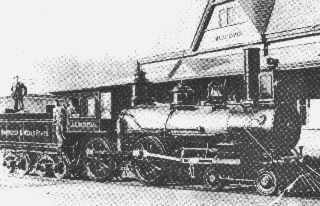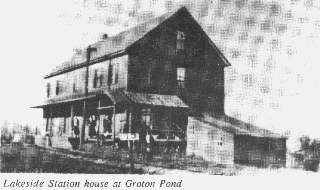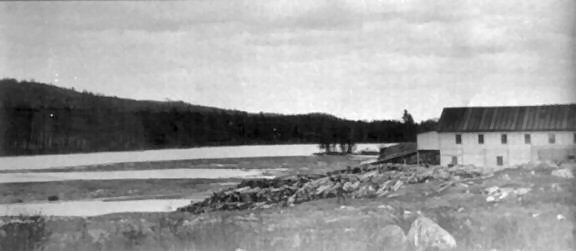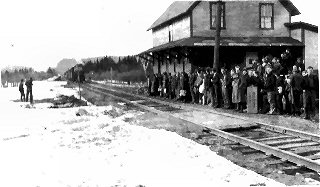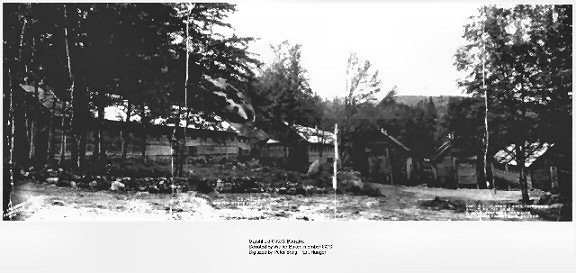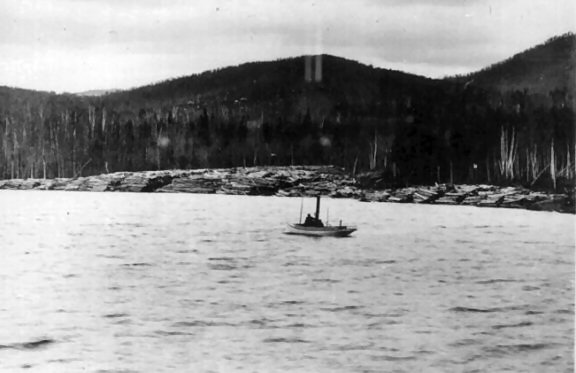Groton Pond History
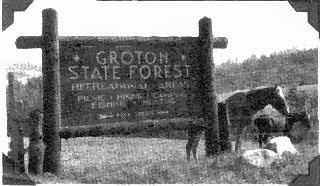
Overview
Wherever you go in Groton State Forest, people have been there before you.Perhaps an Indian trail passed through the woodlands around you. The Abenaki are known to have camped and hunted here, although there is little record of their presence. Soldiers and explorers (often with Indian guides) also passed this way, using Groton as a portage area between the Winooski and Connecticut Rivers.When this spot was in a grove of towering trees, it was probably logged by early settlers. Maybe a poor immigrant tried to farm the rocky soil beneath your feet and failed.In the last century, Groton has seen the dramatic rise and fall of the railroad and the logging towns. But the tradition of camping along the ponds, begun in prehistoric times, has endured.Today, signs of the past are evident throughout the forest. This page will take you to some notable historic sites, but there are clues everywhere, a story for each visitor to unravel.Following is a brief history, a guide to historic sites, and suggested tours by foot and by car.During the French and Indian Wars, Groton was visited by hunting bands of Indians and raiding parties of both English and French. As early as 1704, the area’s network of ponds, brooks and rivers was the route the French and Indians took to carry over 100 captives from Deerfield, Massachusetts north to Canada. Groton was a rugged wilderness then. Mountain lions, timber wolves, and lynx roamed the hills. Recalling these early times, General A. Harleigh Hall wrote in 1877: Here solitude reigned supreme, broken only by the hungry cry of some wild animal. The Indians roamed over the trackless forests or glided swiftly over the placid water of the pond in their light canoes. There were no permanent settlers in Groton until after the American Revolution. Veterans of the war, along with many ambitious youths from lower New England, moved north to Vermont. These pioneers sought water and trails for transportation, land suitable for farming and available resources for building. Groton was settled early, being accessible to the Connecticut and Wells Rivers. Captain Edmund Morse, one of the first settlers in Groton, arrived in 1783. Morse built the town’s first saw and grist mill on the outlet of what is now called Ricker Pond. A sawmill was in operation on this same site until the early 1960’s. Captain Morse also built the first frame house and was the town’s first blacksmith and military captain. The village of Groton was chartered in 1789, The town received this name because many of its settlers were natives of Groton, Massachusetts, The Massachusetts town, in turn, had been named after Governor John Winthrop’s mansion in England. This pattern of naming villages was prevalent in colonial times. The land outside the village was left as “wild land, being too rocky to farm. This region was heavily forested with spruce, hemlock, beech, birch, maple and white pine. Local farmers cut the tree-covered hillsides for fuel, lumber, and the making of potash. Through the years, the main industry has been logging. Sawmills have operated at about twelve different sites in the town of Groton. These include the Goslant Mill at Lanesboro, Ricker’s Mill on Ricker Pond, the Miller and Ayers Mill on Groton Pond, Peabody’s Mill by Stillwater, and Darling’s Mill at Seyon Pond. The mills frequently changed owners, but these are the names by which they are remembered. The Montpelier and Wells River Railroad, completed in November of 1873, gave Groton’s sawmills easy access to a wood – hungry market. With in years, new mills sprang up and old ones enlarged to meet the demand for lumber. This railroad, a connection between the Central Vermont Railroad and the Boston and Maine System, was for many years the only access to the ponds. The railroad opened the area to a another kind of settler – the seasonal camper. The earliest camps along the shores of Groton Pond date to 1894. Within ten years it was an established practice for local Vermonters to spend from July 4 to Labor Day by the Pond. Camps were opened again in late fall for hunting. Disembarking at either Lakeside Station or the Rocky Point Flag Stop, the campers would take a boat to their cabins on distant shores. Then, as now, swimming, boating, hiking, fishing and berry-picking were the main forms of recreation. From the diary of Mrs. Charles Lord, August 22, 1908: We have been here 3 weeks. Have had a fine time. Quite a quantity of fish and berries of all kinds – raspberries, blueberries, and blackberries. The logs were all away here the first of August. The steamer only made a few trips while we were here… The screeching of a wildcat has been heard several times and Ralph saw it once and shot at it. The boys have gone to the foot of the pond… to fish and to get their father who is coming on the 4 o’clock train. There is no virgin forest left. Groton has been heavily logged for timber and to supply the wood-burning trains. The area was devastated by several forest fires (the largest were in 1876, 1883, and 1908) and hit by a hurricane in 1938. The state bought its first tract of land here in 1919 and has continued to enlarge its holdings. By 1975, the forest reached approximately 25,000 acres. The Civilian Conservation Corps, a government work program during the great depression of the 1930’s, was instrumental in park and campground development. The main forest road (Route 232) was started by the C.C.C. They also planted trees and built hiking trails, picnic shelters and stone fireplaces. Groton is now managed by the Vermont Department of Forests, Parks and Recreation for summer and winter recreation, forestry, and wildlife habitat.
The following pages describe the sites located on the map below. Use your browsers back button to return to the map. You may look for these as you travel through the forest. Suggested tours of Groton by foot, mountain bike or horseback are given at the end of this page.
Image Map
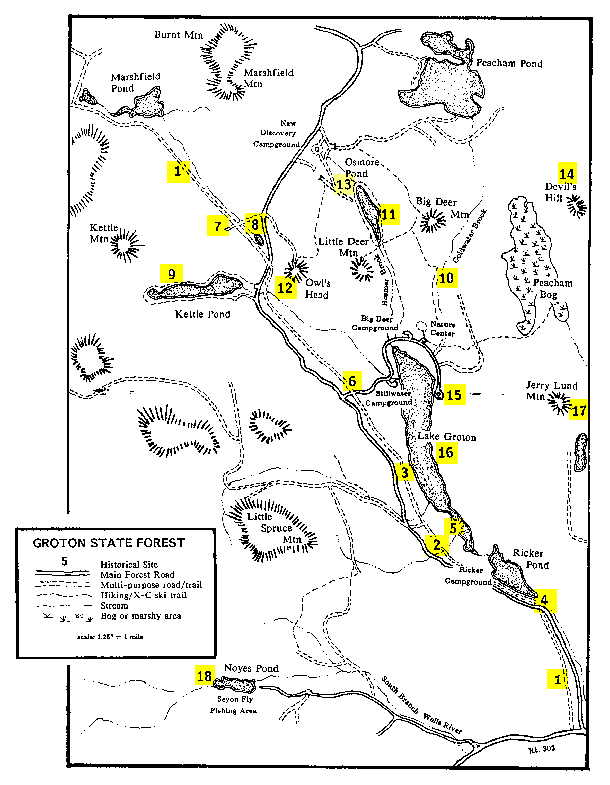
Photos
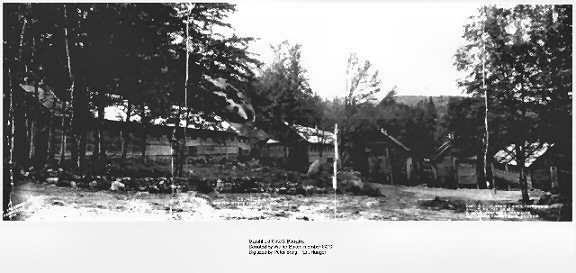
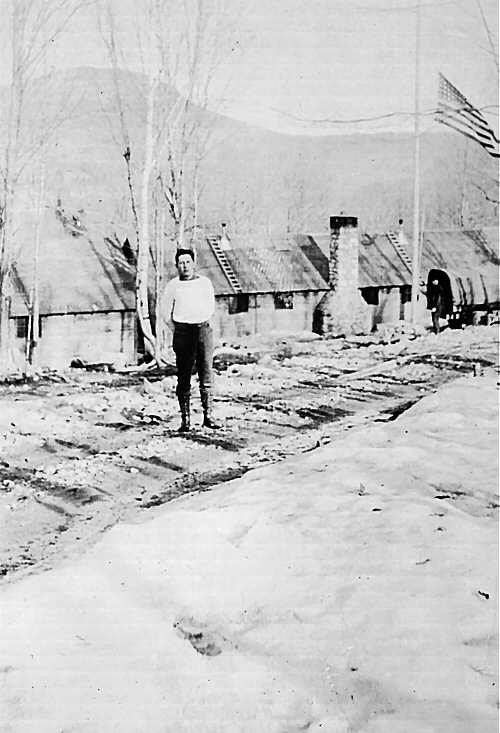

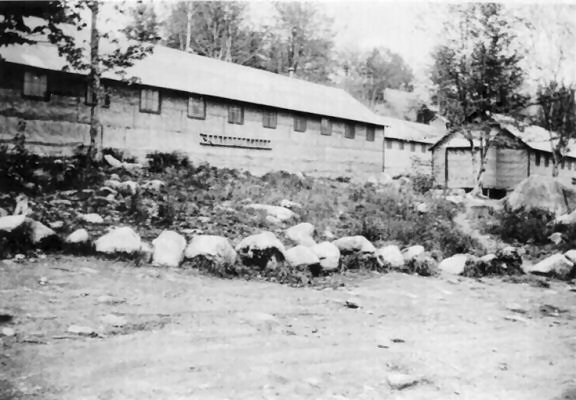
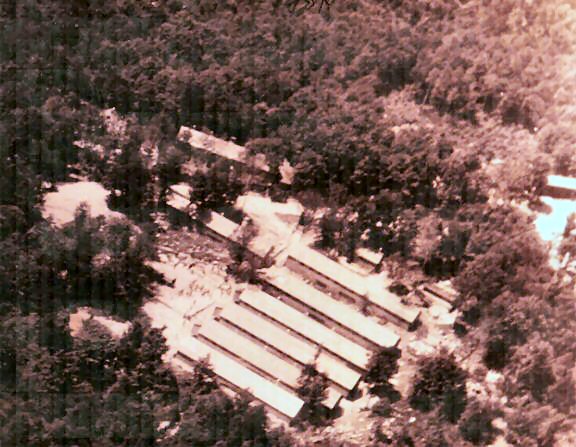
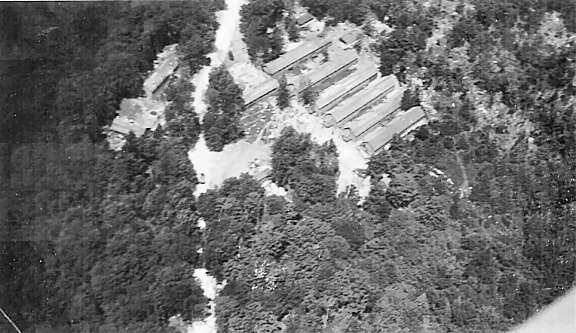

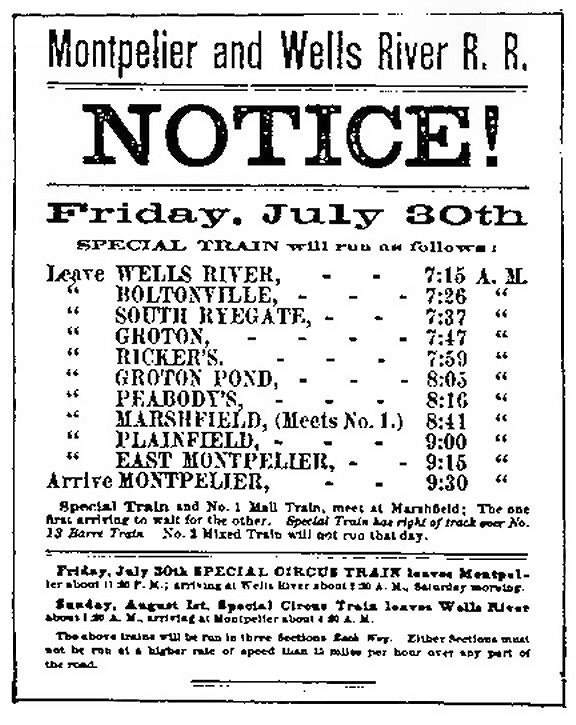
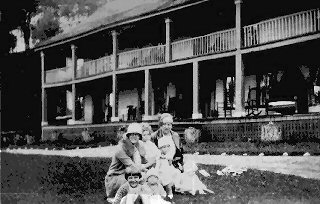
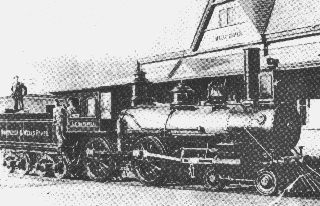




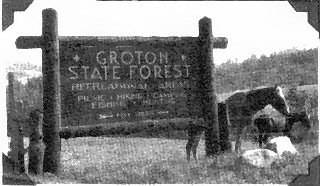
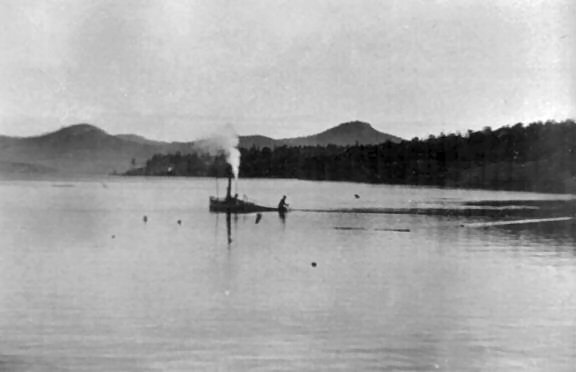
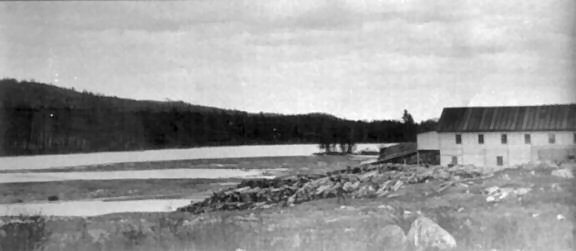
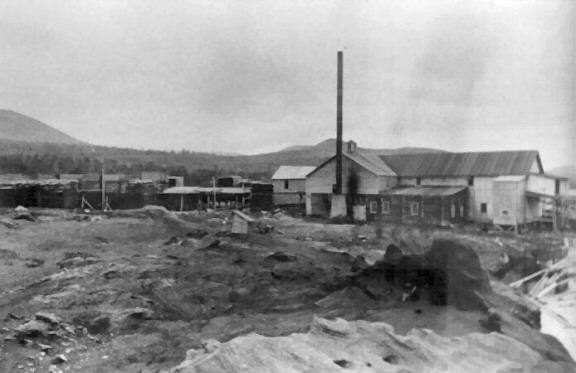
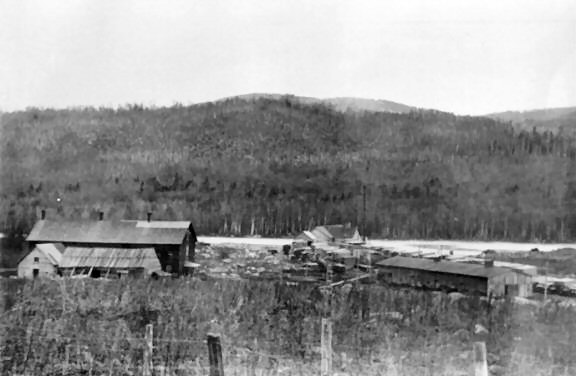
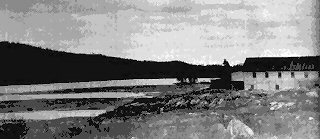
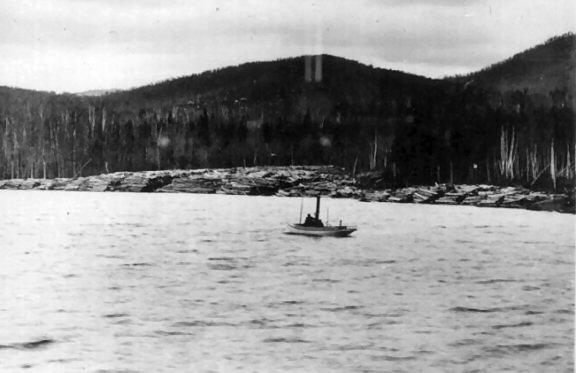
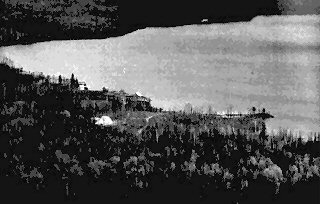

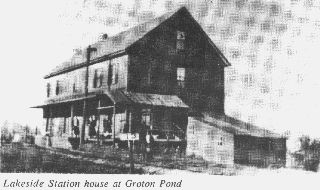
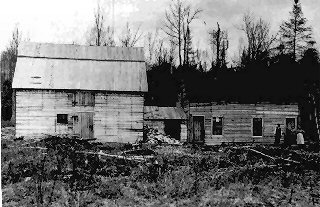

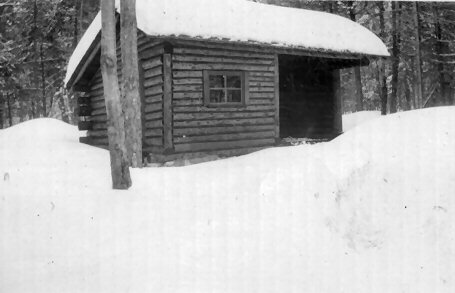
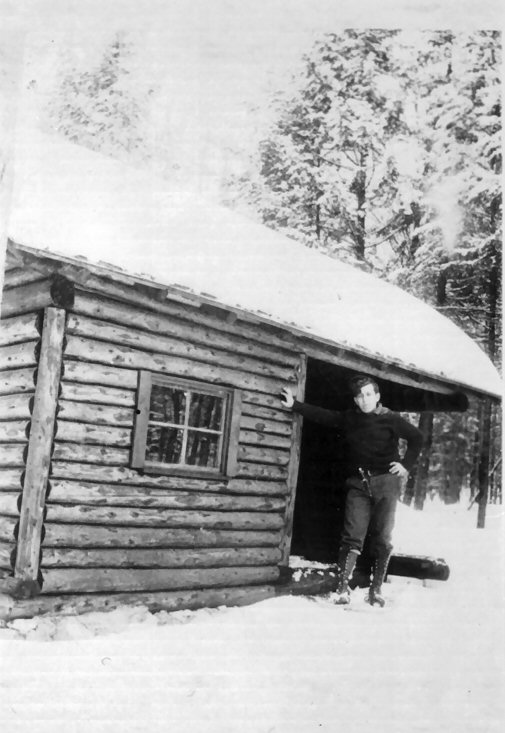
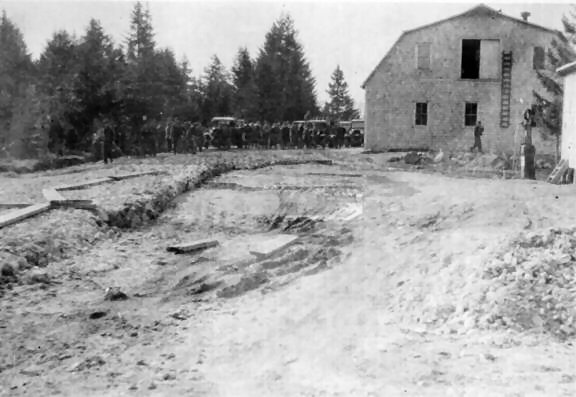
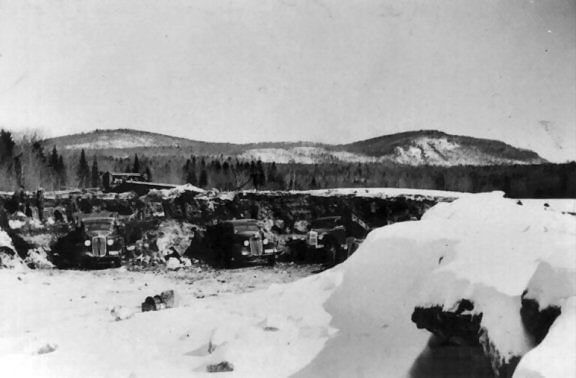
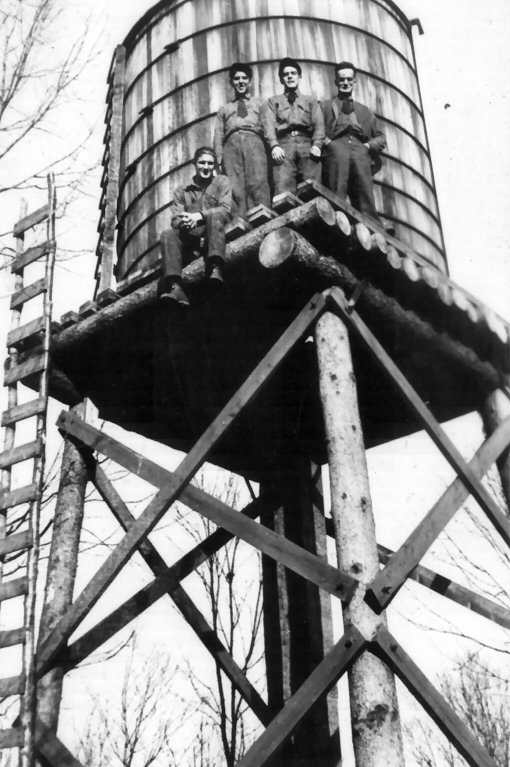


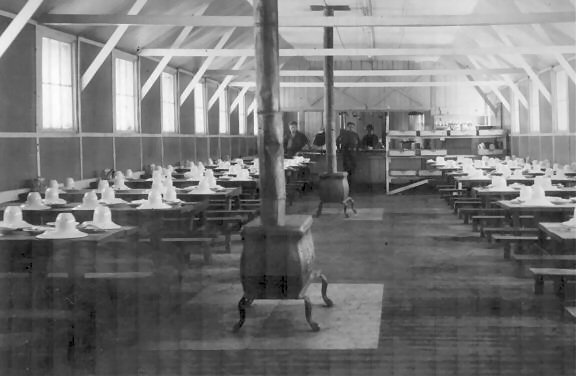
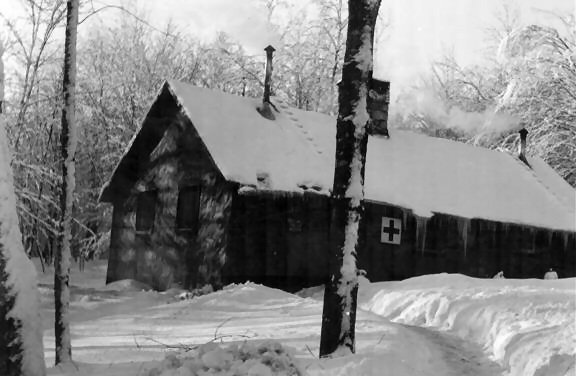
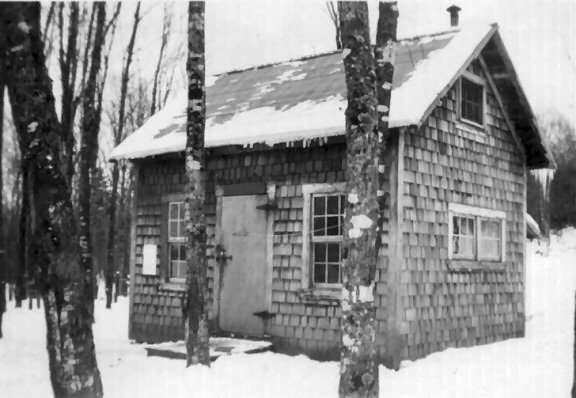
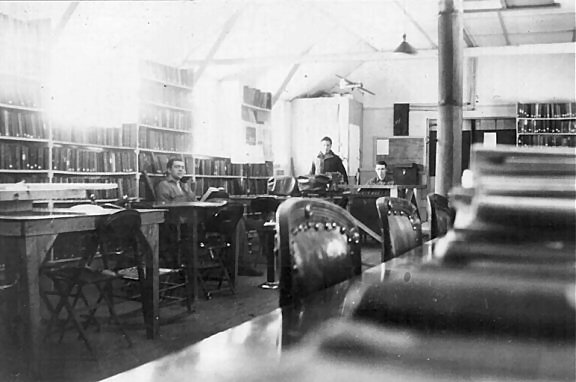
Points of Historic Interest
1. The Montpelier and Wells River Railroad
The railroad bed is now a dirt road parallel to the main forest road. Completed in 1873, the line was closed in 1956. Old railroad ties, now covered with moss, can still be seen scattered over the embankment. In the early 1900’s, when the lumber industry was at its zenith, the train made two trips daily from Montpelier to Wells River transporting lumber and passengers. An enormous amount of wood was cut from the surrounding forest to supply the steam engines. Sparks from the engines were an ever present fire hazard.
2. Lakeside Station
The main train station for most campers, Lakeside was beside Depot Brook at the south end of Lake Groton. All that remains is a cellar hole. From the station, the walk was long, but level, down to the docks on the lake.
3. Rocky Point Flag Stop
Midway on the western side of Lake Groton, the flag stop was an old railway coach with one side removed. The seats on the ends and one side were retained. The site is now marked by a large pile of boulders. Although it was only a short distance from the water, the campers, laden with provisions, had a tough time on the steep, rocky slope.
4. Ricker Mill
From the time when Captain Morse first constructed a mill on this site, a sawmill was in operation here until 1963. The mill was bought by Amaziah H. Ricker in 1857. Ricker ran the mill for nearly 50 years, increasing his property from 100 acres to 2000. Ricker Mill remained in the Ricker family until it closed, making it one of the longest continuously operating sawmills in the United States.
5. The Miller and Ayers Mill
Originally the Groton Pond Lumber Company sawmill, this mill changed hands several times. It was rebuilt in 1904 after the previous sawmill burned when a boiler exploded. The explosion killed one man and is said to have sent a boiler flying across the lake. The mill’s sawdust pile is evident still.THE ROB MILLER MILL GROTON POND, GROTON, VTRob Miller went to work for Michael Goslant as clerk and surveyor in 1896, shortly after graduating from Albany Business College. In 1902, in partnership with V.E. Ayer of Barre, they formed the Miller-Ayer Lumber Company and bought 9,000 acres from Goslant. The previous mill at Groton Pond had been destroyed by fire resulting from a boiler explosion which killed one man. One of the boilers landed across the pond from the mill.Hollis Lund of Groton, a millwright and expert carpenter, worked on the building of the new mill. The other buildings from former operations were still intact and in good shape. These included the blacksmith shop, a storage shed, a barn, the boarding house, two dwelling houses and the station house.Mr. Lund worked from early summer 1903 to about May 1, 1904 on the building of the new mill. The mill commenced operation in May 1904. The new mill was a two story structure with the boilers, engines, shafting, etc. on the ground floor and the saws, etc. on the second floor. The logs were pulled up out of the pond by power on what is known as a wet slip. The sawed lumber was loaded on hand cars in the mill and pushed over rails, out of doors, on elevated runways adjacent to the siding tracks, stacked and dried and then loaded into rail cars. Freshly sawn green lumber was hardly ever loaded directly from mill to car. Generally, hardwood logs were hauled over the ice and snow to the slip and then sawed. The softwood logs were mostly towed down the pond from the ‘log pile’ at the north end of the pond by a small tug boat and sawed in the summer.There were several lumber camps, one at the north end or head of the pond and one on Cold Brook, about 3 miles from the pond and near the west end of the Bog, which was known by some as the ‘French Camp’, as most of the workers were French Canadians. Mrs. Peggy Beamis, who with her husband, Herbert, cooked at this camp from November 1923 to early January 1924 and then moved down to the camp at the north end of the pond. Apparently, they cut trees in the early winter and then as the snow got deeper, they concentrated mostly on hauling the logs down Cold Brook to the ‘Log Pile’. According to Mrs. Beamis, there were as many as 26 men at the camp, mostly French Canadians. (Denerie Vigneault – woods boss – was one of them; also Denerie Bergeron, both could speak English). She says they had everything to cook as Rob Miller was very good about supplying nice food, such as beef butts and baked beans on Sunday – also ham, roast pork and pork chops, eggs and lots of salt pork. She made ten loaves of bread every day, plus a large cake every day and donuts and pies on alternate days. Also they had a pig and a cow at the camp.For breakfast they had boiled salt pork and warmed up potatoes plus coffee, etc. They also had salt pork when they carried their dinners. Apparently the men liked salt pork, as it kept them warm and didn’t freeze so hard that it could not be eaten cold. Most of the men did their wash on Sunday and cut up their tobacco as they brought their own leaf with them from Canada.After she (Mrs. Beamis), Herbert Beamis, and a small son Stub moved to the head of the pond camp, the men carried their lunch, using a ten quart pail for every four men. She always had baked beans for the Sunday meal.Life in the lumber camp, while demanding and arduous, was not without its happier moments – for instance, at Christmas time, Mrs. Beamis and her husband made popcorn balls for the men, which they appreciated very much. They also fixed some onions, but no one (of the men) ate them, so the Beamis’ froze them and ate them later on.While at the camp at the head of the pond, which was bigger than the ‘French Camp’, after supper they would invite Denerie Vigneault (woods boss) to play cards with them in the kitchen. Denerie would bring a different man each time, so that eventually most of the men had a chance to play. These men could not speak English, so Denerie translated for them and all had an enjoyable time.Towards the end of the season when some of the men had left, there was extra room and Denerie asked if his brothers from Winooski could visit them over a weekend and bring something to drink. The men had worked hard all winter with nothing to drink, for Rob had said at the beginning of the season that there would be no drinking. Anyway, Herbert told them as long as they behaved themselves, he wouldn’t tell Rob. The brothers brought 4 pints of whiskey and outside of Denerie’s younger brother (only 16) getting drunk and passing out and finally being revived by numerous dosages of black coffee, there were no incidents of note. They all got to feeling pretty good and whooped it up a bit – about 3:00 A.M. Sunday morning until Herbert told them it was time for bed. Next day being Sunday, they slept most of the day and Monday the brothers snowshoed down across the pond and took the train back to Winooski.The men worked hard and a full nine hour day was put in. I doubt if there were any coffee breaks, etc. However, they were well fed and had a good warm place to sleep. Pay was from $25.00 to $35.00 per month, and keep, for the average worker. Sundays, especially in the early part of the season, some of the men would walk down to the main boarding house and mill and bring back groceries, mail, etc., a round trip of 5-6 miles. This was before the pond froze up solid enough to support a team and while the pond was still open they would get in a large supply of groceries that would keep, such as flour, sugar, bacon, ham, etc. So by getting the heavier stuff in by water, they (the men) wouldn’t have much to carry back to camp. Herbert was with them one Sunday when they walked down to the mill boarding house and Rob, seeing their light loads, thought that they weren’t getting enough to eat, so Herbert told Rob to ask the men and then he explained how they had gotten in a lot by boat before freeze up. Rob said, “smart fellow” and laughed.The stout boy on the right with one white horse (group of teams in front of the head of the pond logging camp) was assigned to skidding logs that day. One time he was struck in the face by the spring pole tightener and quite severely injured; however, on the 3rd day, he was back to work – they sure were tough. That was the only accident they had at this camp all winter, which was an excellent record.At camp in the evenings, one little fellow in his 20’s had a violin and he seemed to know just one tune. We used to get a bit tired of that one piece with the men keeping time with their feet, however, the men enjoyed it and he generally didn’t play much except on Sundays. There were numbers of workers, especially the Portuguese and French Canadians, who must remain nameless, but all worked hard for Rob because they liked him and he was fair to them. As with the French Canadians, there were numbers of the Portuguese who could speak little or no English. They had a spokesman, Tony Silva, who came year after year. The Portuguese were employed mostly in the mill, mill yard and log pile – they had nothing to do with the cutting of timber, etc. I remember of two families staying at the head of the pond lumber camp in the summer, the men working at the log pile rolling the logs into the water and making up the rafts or booms of logs for the steamer to take to the mill. These men were often in the water up to their waists and in early summer the water was cold. My sister and I used to play on the sandy beach with 2 children of these families. These children were about our age – ten to twelve years old.They were nice kids and could speak English. Many hours I have spent in and around the mill area and the station house. We would arrive by train and carry our baggage down the road which was filled, in with sawdust in spots, generally stopping at the water tub opposite the old schoolhouse. There was a gate across the road near the station which kept the live stock from straying onto the tracks and there was a side gate for foot traffic. We were always very conscientiously closed. these gates if we used them. I was fascinated. by the powerful steam engine when in operation – also listening to the steady pulsating exhaust was intriguing to a 12 to 14 year old. I remember going upstairs and watching the sawing of a log. At the barn we sometimes stopped to get fresh milk practically from the cow. The boarding house had an appeal of its own, especially the store and small post office. In back of the counter on the wall hung axes, cross-cut saws, and woodsmen’s tools. There was even candy to be bought – the two items I remember were the assorted paper wrapped kisses, and a miniature sauce pan with a tiny spoon to ladle out the filling in the pan. It was nearly a mile from the station to where we embarked by water for our camp at the extreme northern end of the pond. In the summer there were generally cows and. horses grazing alongside the road. It must have been rather poor picking for the animals for the cleared surfaces were covered with stones. Austin Lund relates that when he lived at Groton Pond in the station house (his father Hollis Lund worked on the building at the new Mill) he and other children went to school in Groton commuting by train each day. At that time, l903-1904, the old sawdust pile was still burning and the children were warned never to go near this area, as every now and then it would cave in where it had burned underneath. The old sawdust pile burned for several years – at least 7 or 8. The new mill had a 125 h.p. a steam engine plus a smaller 25 h.p. that ran the generator for electric lights. He says the day they started the generator his dad took his mother and the children to see the electric lights in the boiler room. The first such light he had ever seen and that probably would apply to his mother and dad. Later on a 35 h.p. engine was installed to operate the band saws which sawed out chair stock. Austin says that they lived on the second. floor of the station house. The first floor although vacant at that time was equipped with store counters and also in the past a post office evidently had been there. At that time all mail for Groton Pond was delivered to Ricker’s Mill Post Office and had to be gotten there. From Sept. 1903 until early Dec. l903, he carried the mail during the week, getting off the train at Ricker’s, picking up the mail and walking the track to Groton Pond. Rob gave him $.10 a day for this chore. Incidentally, one of Austin Lund’s ancestors, Jeremiah Lund, settled in the vicinity of Levi Pond and Jerry Lund Hill gets its name from him. There are today, several cellar holes and old stone walls indicating that at one time this particular area was farm land. At one time the Lund family owned considerable acreage in this area as well as around Ricker’s and. Groton Pond. The so called Annis clearing was a portion of these holdings. W. J. Bushey notes that he worked for Rob from Dec. 1921 until Dec. l924, most of the time in the wood cutting both logs and pulp. He says that from old timers he heard that a man named Cole built the “up and. down” sawmill on Cold Brook. (The only name rather vaguely I ever heard it called was the Jack Carpenter Mill). It wasn’t much of a mill as the volume of water at this location is not very great. The stone foundations are still visible and it is about 1 mile up Cold Brook from the head of the pond. Mrs. Rogers tells me her uncle Almond James of Groton worked in this mill and it was an “up and down” affair – that would make it around 1865 when he worked there. Also Henry Bradley of Peacham says that his father worked in this mill about 90 to 100 years ago. Frank Jones was a teamster around this time (1918 – 20), and, he quite often used 2 to 3 pair of oxen to bring logs from the “French Camp” to the “log pile.” Sometimes in the early part of the winter season some of the horses, equipment, etc. would be brought in by a trail on the west or railroad side of the pond, that extended all the way from the mill area to the lumber camp at the head of the pond. Nelson Smith generally worked. in the mill and relates that he was working in the mill the last day the board. saw operated and they finished up by sawing up the “boom logs” which were used in towing the logs down from the “log pile”. This last summer of operation was 1924, although they sawed out chair stock a while longer the same year. He relates that on Sundays during the summer time they used to go swimming using the beach at the Ayer Camp now owned by Doug French of Groton. My brother Ralph says that the first time he went to the pond from Groton with my father and Frank Perry of Barre around 1900, the station house, the school house (opposite the water tub), a house on the left or north side, the boarding house, the barn and the blacksmith shop were in existence. The mill itself was gone having burned, as related above. Billy Gay and family lived in one of the houses. He must have, been a sort of caretaker. Fishing in the pond and brooks was very good. No trouble in catching a meal of fish. He worked for Rob Miller during the summer of 1911-1912 and ran the steamer. Alex Hall of’ Groton was his roommate and was bookkeeper and clerk. He says Rob Miller had three different steamers and the one he ran was about 25 feet long, wide beamed and a solid roof. It was powered by a 10 h.p. steam engine, and burned slabs in the vertical boiler. At that time the camp at the head of the pond was run by Mr. and Mrs. Charles Lakin of Marshfield. The woods boss and yard boss was Israel Jewett. Mrs. Lakin was also cook at the Mill boarding house. Mrs. Israel Jewett was also cook at the boarding house. A child’s sleigh and jumper, which were made by the blacksmith in his spare time, are still in use by grandchildren of Israel Jewett. Rob Miller built a two tenement house on the south side of the road near the boarding house. Mr. and Mrs. George Taplin and small daughter Evelyn lived in this house around 1920. Gus Tellier and wife lived here before them. Mrs. Taplin ( now Nellie Rogers) worked part time in the boarding house and Mr. Taplin was barn man, steamer operator and general handy man He worked for Rob, off and on, from 1910 to around 1921. Mrs. Taplin relates how the French-Canadians came as a group by train with their belongings and after reaching the pond by the mill, Mr. Taplin would take them by steamer to the “log pile.” This event occurred in mid November sometimes there would be a thin layer of ice around the shore line. The Crew would then be carted by team to the “French Camp” and would immediately start cutting. Another time Mrs. Rogers relates that she went with her husband George when he took a load of groceries up across the pond on the ice on a cold day in the winter of 1920-21 to the “log pile” where Frank, Jones with 3 yoke of oxen was there to take their load the rest of the way to the French Camp. He (Frank Jones) mostly drove oxen and he had brought a load of logs down to the “pile” that day. In the winter Mr. Taplin’s main job was to get up at 3:30 each morning build fires in 5 stoves at the boarding house, then go to barn and do the chores there, including getting the teams ready for the day. Breakfast at 6 a.m., work day from 7 a.m. to 5 p.m. with 1 hour out for lunch. and supper at 5:30 p.m. – no work on Sundays. If a teamster was sick, Rob took his place that day, for a team couldn’t stand idle all day. In the summer, he (Mr. Taplin) operated the steamer most of the time. There were 5 or 6 double teams at the barn plus a few cows to care for. Mrs. Rogers says that Ida McRae was a teacher in the school at Groton Pond – that must have been when the previous mill was in operation. Also Nellie Wead was cook at the “French Camp” during the winter of 1920-21. She also relates that Mr. Smith of Barre was a silent partner of Mr. Ayer – he was a brother-in-law of Ayer. He ( Smith ) built a camp on the pond where the Beaver Dam Brook enters (camp now owned by Doug French). This camp had a fireplace, flush toilet, running water and even electric lights supplied by a home generating plant. The stones to build the fireplace were shipped in bags on the railroad and Mr. Taplin drew them down from the station with a stone boat. After, Mrs. Ayer got sick and couldn’t be at the Smith camp, he (Mr. Ayers) had a room of his own at the station and he and Rob always ate at the head of the table at the boarding house. The boarding house, so called, was where the workers in the mill area ate and slept (with the exception of several married men living in the two houses) – it was a large two story building with sleeping quarters on the 2nd floor for 40 men – 2 men to a room, and on the first floor there was the kitchen, dining room, a large recreation room called the “bar room” and another room housing the office, store and post office The “bar room” was a hold over from other operations. as no liquor was ever dispensed here Rob was very strict about drinking and gambling and as a result these activities were kept at a minimum. As related above, the men did occasionally consume a bit of whisky, but if Rob ever found out, they would have been “going down the road” quickly. As at the logging camps, the men were well fed. The menu consisted of roast pork, boiled and roast beef, fish, beans and salt pork, pies, muffins, biscuits, doughnuts, cake, brown bread, oatmeal, tea, coffee and milk. Mrs. Rogers quite often worked at the boarding house – she got $2.50 a day and her husband got $30.00 a month, a house, fuel, and milk, so all together considering the times, it wasn’t too bad. All houses including the station house were wired for electricity which was supplied by the steam driven generator at the mill. In addition to the electric lights an ample supply of kerosene lamps and lanterns were on hand for any emergency. One time Mrs. Rogers worked in the boarding house from early September till mid December. Rob had a map hanging on the wall which showed where the operations were, so whenever he went out to mark a section for cutting he would show Mrs. Rogers on the map where he would be for that day. The mill was served by a spur track from the main line of the Montpelier and Wells River Railroad about 1/2 mile away and somewhat lower in elevation As a consequence of this grade from mill to main line the small engines of that time could only haul 1 or 2 loaded cars , and several times would have to make a second try to get back up on the main lines with a load. At the mill area there were 3 side tracks from which cars could be loaded. At the height of its career, the railroad maintained several daily passenger trains from about 7 a.m. to 11 p.m. It ceased operations in November 1954 after 80 years – today, portions of the track right-of-way are used as access roads by campers. There were stations at Rickers, Lakeside, Rocky Point and Lanesboro – sometimes trains would stop for a group at an informal stopping point known as Tin Pan, which was near where the present Stillwater road crosses the railroad right-of-way. Besides sawing out all kinds of boards and dimension lumber, the mill also operated several band saws which were used to saw out “chair stock,” so called, because the hardwood pieces were rough sawn in the shape of chair parts such as rockers, backs, seats, etc. Other blanks were sawn for baby carriages, etc. I suspect that earlier in the operation, clapboards were also sawn out. -Marvin Boomhower- When the Soules Mill in Plainfield closed down Marvin Boomhower and his family moved to Groton Pond where Rob Miller had a large lumber operation and a large saw mill. Here the power was from steam, and folks say the board saw ran like lightening. Not less than three or more than seven million board feet of lumber came out of this mill in a year. The men worked 9 hours a day nearly all year around. The freight cars on the three spur rail road side tracks had to be kept filled and ready to go. In the years, Marvin Boomhower worked in the mill for Rob Miller, there were 100 men employed, 28 teams of horses, 4 lumber camps running in the woods, a large boarding house, a horse and cow barn, a school house, blacksmith shop, several private homes, saw mill and dry house for lumber, a very pretty railroad station in which 3 private families lived, all this made up this the bustling lumber concern at Groton Pond now called Lake Groton. After Miller ceased operations Marvin went to work for Harry Ricker and finished out his career as a board sawyer there.
6. Peabody’s Mill
The site of this large steam-powered mill is just north of the Stillwater Road crossing. Located adjacent to the newly constructed railroad, the mill was in a favorable position to market its lumber. The train stopped here for campers at an informal flag stop known as the “Tin Pan Flag Stop”.
7. Lanesboro
In the heart of the forest, though not in state ownership, is the abandoned lumber mill community of Lanesboro. The Lane sawmill was later bought by Mitchel Goslant. On the hillside was a large lumber camp with a boarding house, blacksmith shop, general store and stables.
8. Goslant’s Pond
Now named Spice Pond, this small pond used to be on the property of Mitchel Goslant. Goslant owned thousands of acres in the Lanesboro area.
9. Kettle Pond
According to one story, Kettle Pond received its name when Aaron Hosmer, a hunter and adventurer who roamed the woods of Groton in the mid-1700’s, dropped his old camp kettle while crossing the pond on a log. Another story tells of “Bristol Bill”, a renowned counterfeiter and bank robber in the US and Europe in the mid-1800’s. Some say Bill buried a kettle full of counterfeit bills beside what is now Kettle Pond. Captured in the village of Groton, he was brought to trial in Danville. There, before a stunned crowd, he stabbed the prosecuting attorney with a case knife.
10. Coldwater Brook
Up Coldwater Brook, the stone foundation of a old waterwheel-powered mill can be seen. This was a small up and down sawmill which operated before the Civil War.
11. Osmore Pond
This pond received its name from Aaron Hosmer, a hunter who camped here before any permanent settlements existed.
12. Owl’s Head
Owl’s Head is easily reached by road and a short foot trail to the top. It offers excellent views of Groton State Forest and surrounding area. Several ponds are visible and the old railroad bed can be seen as a straight line running through the forest. The road up to Owl’s Head, the picnic shelter, the trail to the summit and the stone lookout were built by the Civilian Conservation Corps.
13. Civilian Conservation Corps Camp
The Corps had two camps in Groton, one near Osmore Pond and the other by Ricker Pond. Composed of unemployed men from Rhode Island and New York, The men worked for $30 a week, $25 of which was sent home. Stone chimneys from the Osmore Pond camp can still be seen.
Marshfield C.C.C. Camp 146th Company #???? S-51-VT
The 146th Company C.C.C. was organized at Fort Adams, Rhode Island on June 1, 1933. It occupied the Groton Camp, S-51-VT., Marshfield, Vt. on June 13, 1933. The original project was principally construction of a road (Now known as route 232) from US 2, (Old Vt. 18) at Marshfield, to route US 302 at Groton. Since completion of this road the project has been largely development of the Groton State Forest for recreational areas and timber improvement. Hurricane and fire hazard reduction work has also been done since 1938.
Ricker Mills C.C.C. Camp 1217th Company #2192 ?-??-VTA
THE ENROLLEES ARRIVE A bitter, wintry wind was dizzily whirling flakes of snow in every conceivable direction when the wobbly, overcrowded train panted to a stop with a seeming sigh of relief at Ricker Mills, Vermont. From its confines poured a nondescript stream of khaki clothed individuals who gazed about their bleak surroundings in bewilderment as they drew up their collars and hunched their shoulders in defense from the penetrating wind and biting snow. With the coaches no longer bulging with humanity the train puffed lightly on its way, and now on this cold, somber day late in November of 1933, we see what we recognize as the man-strength of what is to be Company 1217, Civilian Conservation Corps. At an order from an officer the men shoulder their barracks bags and trudged through the already deep snow up a short steep hill to “home” for the next six months. Riding from New York City in a crowded day coach, with no rest is not much fun and the boys are tired and hungry. As they plodded wearily through the deep snow they strained their necks in eager anticipation for a glimpse of the camp, and it seemed that their weariness left them as they approached the grounds. As they breasted the top of the sharp climb and turned abruptly to the right, the entire camp area was brought suddenly into view, and like the hiss of escaping air from the punctured bladder the spirit of the boys seemed to escape them. Picture if you can a desolate, scrubby, rock strewn, swampy area covered in part by partially completed, bleak looking buildings and everything about the place in seeming disorder. Add a touch of nostalgia, a feeling of weariness, a knawing emptiness in the pit of the stomach coupled with the knowledge that you have to rustle your own food and then tell me that your spirit wouldn’t leave you under the same circumstances. But a spirit born of necessity is soon revived, and before the men were in camp a half hour, pots were boiling in an improvised kitchen and fires were crackling in the bare buildings. It is a tribute to the courage and integrity of these young men, and to the foresight and ability of the army and forestry personnel under whom they worked, that the squalid, unattractive buildings were soon completed and transformed into cozy, livable quarters, and the surrounding area made pleasant to look at. WORK BEGINS After this preliminary work on the camp buildings, the enrollees began work in the adjacent Groton State Forest, which comprises 15,300 acres and includes within its boundaries six ponds, the largest of which is Lake Groton. The camp itself overlooks Ricker Pond, a body of water approximately two miles long. Proposed work to be done in the forest included, in the main, road and bridge building, forest stand improvement, insect pest control, tree and plant disease control, and the erection of public camp ground buildings. SUMMARY OF WORK ACCOMPLISHED The following impressive summary shows at a glance the amount and kind of work done from January 1, 1934 to March 31, 1935:TYPE OF WORKMAN DAYSReduction Fire Hazard, 103 acres1,134Roadside Clearing and Cleanup, 7.5 miles387Trail side Clearing and Cleanup, 3 miles326Forest Stand Improvement, 439 acres11,539Roads and Truck Trails, 4.5 miles17,309Public Camp Ground Clearing, 25 acres578Public Camp Ground Buildings, 1835Other Camp Ground facilities, 150Other Structures, 4198Water System (a) Storage Facilities, 2180Water System (b) Pipe Line, 1799 feet291Insect Pest Control, Trees, 63 acres1,075Tree and Plant Disease Control, 2151 acres1,856Survey, Linear and Boundary, 33.6 miles463Bridges, Vehicle, 2773Water Improvement, Stream, 1 mile23Fire Wood Cut, 1831 cords—-Total Man Days45,403 ROAD THROUGH FOREST COMPLETED A road has been built through the heart of Groton State Forest by the Ricker Mills and Marshfield C.C.C. camps and connects Route U.S. 302 in Groton with Vt. 18 (Now Vt. 2) in Marshfield. This scenic short cut effects a saving to motorists of approximately 26 miles. In the four miles of road that was constructed by the Ricker Mills boys, a firm base for this surface dirt was provided by 10,000 tons of broken stone. Three tons of dynamite were used in blasting, and more remarkable than the amount used is the fact that it was used without a single casualty. CAMPER’S DELIGHT A typical work project carried out by the enrollees of this company was the construction of a picnic ground for the benefit of the many campers frequenting the lakes and ponds of the state during the hot summer months. Nestling on the shore of Ricker Pond, surrounded by fragrant balsams and fresh white birch, the enrollees have erected a sturdy looking log shelter reminiscent of pioneer days. The surrounding area supplied the innumerable large granite rocks which the enrollees drilled and shaped into a large matched fireplace. This they overhung with a picturesque mantel hewed from a water soaked log retrieved from the bottom of Ricker Pond, where it had reposed unmolested for a number of years. Immediately below the mantel and in the exact center of the fireplace is embedded a large chunk of glittering quartz. Toilet and washroom facilities with running water for both men and women have been provided in rooms adjoining the main building. The water is piped to the cabin from an underground spring which was located a thousand feet distant, in another part of the state forest. At various points of vantage surrounding the main log shelter attractive stone fireplaces have been built for the accommodation of those who wish to cook their meals over an open fire. In addition to tables and benches made of wood, the enrollees have constructed seats and tables from flat slabs of rock in some instances, and from drilled rock in other cases. Neat and attractive rustic foot bridges span small ravines and in every detail of the project the workers have succeeded admirably in creating comfortable camping conditions while preserving an outward appearance of primitive and unspoiled beauty. The pond abounds with fish and the forest with wild game, but those who care for neither hunting nor fishing may take a leisurely boat ride or sun themselves lazily on the shore of the pond. The camping grounds are easily accessible by way of Groton and Ricker Mills over the improved road built by the enrollees of the 1217th Company, and by way of Marshfield over the road built by the 146th Company. Such projects as these are well worth while and fill a distinct need in the state of Vermont. THE EDUCATIONAL PROGRAM As the C.C.C. continued to demonstrate its worth to the nation, plans were made for its continuance and provisions for the welfare and general well being of enrollees were supplied. Educational advisers were appointed to all camps; libraries, books, magazines and daily newspapers were provided, and an educational program – the experiment on the “school in the woods” – was begun in this camp as well as the hundreds of others. From its lowly beginning with the adviser and possibly several enrollees leading the limited discussion groups in bare, poorly lighted rooms, and with only a small percentage of attendance, the program has steadily expanded until at present we find subjects such as leather-craft and woodworking up to radio and electricity being taught by the adviser, the army and forestry personnel, FERA instructors, and in some cases by the enrollees. Attendance records have been brought up well beyond the 50% mark, and this fact alone, in a program that is entirely elective, should indicate as to whether or not the so called “experiment” has been a success. Even the die hards have conceded a victory. A brief summary, such as this, of the educational program of any one camp does not reveal any of the inconveniences under which the program was carried on, or any of the obstacles that were overcome, but in all fairness to these educational advisers some tribute should be paid to their characteristic, dogged persistence and tenacity of purpose that finally resulted in a successful educational program. RECREATION Sports of all kinds and the necessary equipment is provided in camp. Interest is stimulated by inter-camp rivalry in indoor and outdoor games, especially baseball, the national pastime. Trucks are furnished several times weekly for educational and recreational trips. Dances and plays are put on by the camp in the nearest small town, Groton, almost four miles distant, as a means of developing and maintaining a cordial relationship with the townspeople as well as for the enjoyment it affords. A newspaper, “The Ricker Breeze”, composed and mimeographed entirely by the boys in camp, is circulated within a radius of twenty eight miles, and all in all, every possible effort is made to make the stay of the enrollees in camp as enjoyable as possible. SUCCESS Under the able leadership of its commanding and technical staff, Company 1217 can point with pride to the amount of valuable work that has been accomplished in the Groton State Forest, and can say without fear of contradiction that every dollar spent in the work has been justified. We agree wholeheartedly with Robert Fechner, Director of Emergency Conservation Work, when he says: “The C.C.C. has proved so effective as a relief and conservation agency that I recommend it be made a permanent part of the federal establishment. The Corps has proved a social and economic success. It has demonstrated that large numbers of unskilled young men can be put to work at short notice on constructive forestry and conservation projects that are productive of lasting benefits not only to the men themselves but to the economic life of the state and nation.” The following men comprise the army and forestry personnel of the camp who are in charge of the enrollees:
NAME, TITLE
Captain Gerald Potts, Inf.-Res.CommandingLieutenant
Morris R. Dowd, Inf.-Res.Mess OfficerLieutenant
James F. Farmer, Cav-Res.Exchange Officer
Gino Carmolli, Camp Educational Adviser
Dr. Harry Y. Twiss, Contract Physician
Cheney Newton, Camp Superintendent
Alfred Bishop, Junior Forester
Leroy Kinsley, Senior Foreman
Paul Nelson, Senior Foreman
Joseph Bingham, Senior Foreman
Lynwood Hoyt, Junior Foreman
Elmore Dutton, Junior Foreman
Clarence MacDonald, Junior Foreman
John Priest, Motor Mechanic
William Hartwell, Blacksmith
14. Devil’s Hill
The story goes that a Peacham man was heading home over the ridge one evening and saw a large, dark bird over this hill. He swore it was the devil and ever since this has been Devil’s Hill.
15. The Log Pile
North of Boulder Beach was “The Log Pile.” Logs cut in winter and skidded down the mountains on oxen-drawn sleds were stored here until spring. When the lake ice melted, a Miller and Ayers steamer would tow the logs to the mill at the foot of the lake.
16. Lake Groton
This lake has had several names. One of the earliest was Big Lund, after Silas Lund who owned a large amount of land. It changed to Long Pond, then Wells River Pond. For many years since, it has been known locally as Groton Pond, or just the Pond. GROTON POND CAMPING My folks tell me that I first went to the Pond when I was about 1 year old, the summer of 1903. My recollection of being there was one time when my father and brothers were putting on roofing on the porch on Camp Fairview and during this process a large hawk was seen flying over the pond near camp. This would make it the summer of 1906 or 1907. The next incident I recall was when my father went to get some drinking water in Cold Brook after supper and hearing him holler for someone to bring a gun . I thought at least he had seen a bear, but it turned out he had treed a porcupine, which they shot. Another time after supper, a group of men and boys scared up a half grown rabbit which they more or less surrounded and my father caught it by making a dive and getting it by the legs. They eventually let it go. At this time it was pretty much open in that area, only a few small trees and brush. I also recall the time that my mother took a picture of Alice, Wendall and myself gathered around an old pine stump. Wendall is just standing, Alice was looking for a butterfly and I was painting a small toy boat. (The stump was still visible in 1970.) It was at the next camp, the Carpenter’s, (now owned by Proudfoot) and I believe the Tellier family was staying there, that I got my first taste of dried beef. It came in a round tin can of at least 5 lb. capacity. The contents were wrapped in a sort of butter paper and the container had a removable top or lid.There were several camps nearby, all owned or occupied by Groton people; the Clarks, Carpenters, Pillsburys, and Dr. I.N. Eastmans. Other camps farther down the lake on the east side was the Plainfield camps; Batchelors and Balls. The Gale’s and Edson’s camps were on the west side about halfway down and then further down on the same side was Robinson’s (they had a sailboat) and the camp built by Ayers. There were several others and all these were built by 1910 or a few years later.When people went camping in those days it was for a week or more and large amounts of food, clothing, etc., were taken in on the first trip, as transportation was not as convenient as now. We came by train to Lakeside (the station nearest the foot of the pond) where all the baggage was toted nearly a mile to the pond’s edge (or a team could be hired from the mill to haul the articles) then all the stuff was stowed in a boat, rowed the length of the pond and carried into camp. There was no road into the area, no refrigeration (later on some campers put up ice) no electricity, no telephone and no outboard motors. So it was expedient to bring everything in on the first trip, if possible. Once settled in camp, things leveled out and one could relax. Some common staples of food and milk could be gotten at the small store operated by the mill. There was also a post office there.Up until around 1924, the mill was operating and during the winter, logs were cut and hauled to the so called ‘log pile’ near the present State bathing beach (Spencer’s camp) (Boulder Beach). A small steamer made trips daily on the pond to haul these logs to the mill and so groceries were sometimes delivered to the log pile where they were picked up by the campers. Most lake transportation was by rowing or motor boats. I still like to row.In the early days, there weren’t too many other kids to play with. I recall the Tellier girls, Peter Thurston, Nelson Ricker, Franklin Clark, the Frost kids and occasionally some kids from Groton. There were other children on the pond, but they were strangers and we seldom got to know them. Such was our limited world. I remember the forest fire of 1908 (I was nearly 5 years old) which started one hot day in mid-summer in back of the Plainfield camp. They said it was started by the dumping of hot ashes. Anyway, it got going in mid-day and spread eastward up the slope towards Jerry Lund hill and became quite a fire. I recall it burning at night and seeing the flames shooting or flaring up, as it burned some particular trees. Some of the men from Miller’s mill came to protect the pile of logs at the ‘log pile’. Also, some of the men campers went to the scene and they did save Ball’s motor boat, but not the camp. The fire burned for quite a while and over a sizable chunk of land, mostly Ricker’s. Next summer, we kids were able to get birch bark from the standing fire killed white birches and we made torches of this material. I can’t remember much fishing or boating at this stage of things. What we ate or how I slept is all blank. Needless to say, my waking hours were concerned only with playing. Cooking was done on a wood stove and some perishables were placed in a tight metal container and kept in Cold Brook. At first, our drinking water came from Cold Brook and then later on from a small stream that comes from the area where Deer Mountain State camp now is. (Big Deer Campground) In 1910 my folks sold Camp Fairview and built another camp directly westward across the pond. This camp (Greyledge), is now owned by my sister, Alice Goodine. The area at that time was heavily wooded and there were no camps in that area. Am Hooper, about this time, built his camp (Rockhaven) on the next lot northward, now owned by Tom Eastman. Am used to refer to the area across the pond where Fairview was, as “Bingville”. He liked to camp and fish in the pond. He lived on a farm Peacham way, near the North Ryegate school and many a time he would cross lots through the woods from his farm to camp and return. As with camp Fairview, the new camp was built as economically as possible, the rafters, studding and floor joists were all poles which were cut in the so called swamp near Stillwater Brook. The siding and roof boards were square edged, random length hemlock, which I believe cost all of $9 per M. The lumber was gotten at Miller’s. Frank Hanchett out on the roofing and the sides were covered with a metal siding that simulated brick. We sometimes walked down to camp from the railroad following the Tin Pan Trail. I recall much more about fishing , rowing, and swimming at this time, as I was much older. We got our drinking water at the head of the pond from the same source that the Forest service now does (Big Deer pump house). We had acquired a small ‘steel boat’, this boat was easy to handle and row and I spent a lot of time in it. Also did more pond fishing, a meal of perch could be had most any time. Also in season, there was an abundance of blue berries and a lesser amount of blackberries and raspberries. Dr. Tillotson built a camp just north of Am Hooper’s so we had a tight little group of camps. I remember the Dr. and one of the Emery’s (Archie, I believe) planting the Scotch pine around his camp, and also seeing them start lining out a swarm of honey bees. For kids to play with, there was Franklin Clark, whose folks spent a lot of time at camp (especially his Grandmother Clark) and periodically other Groton kids. By midsummer, the level of the water in the pond had fallen low enough, so that we kids could traverse around the head of the pond way over to where the State bathing area now is. We played many a game of “duck on the rock”. etc. near this area. Rocks and two small islands became visible and we sometimes played train by leaving passengers on these rocks and islands and then picking them up later. We also made small dams, etc. where the brooks entered the pond and of course we were constantly in and out of the water. I recall Franklin and I fishing down at the foot of the pond opposite the mill and also getting milk and groceries at the store. For a couple of summers, my brother Ralph ran the steamer for Miller and I had quite a few rides in it. It was thrilling. I was about 10-11 years old at the time. After the big fire of 1903, which started in Lanesboro and burned over Owl’s Head, Little Deer and Big Deer mountains, Stillwater campground and as far easterly as Cold Brook and part way down on both sides of the pond, plus the fire of 1908 left lots of standing dead trees, plus good feed for the deer, plenty of wild flowers for the honey bees and lots of blueberries, all flourishing in the 20-25 years after the fire. Now it is particularly grown up and the deer , blueberries and honey bees have been drastically reduced. At one time there were quite extensive beds of rhododendron and trailing arbutus, but these have been stifled out by the growth of the woods. At the pond side near Rocky Point, there were quite extensive beds of rhododendron and lesser ones at the foot and head of the pond. Trailing arbutus could be found in the swamp area near Stillwater Brook, also blueberries here. At one time around 1914-15, people came from miles around to pick blueberries. At one time, Gus Tellier was out picking blueberries in a lumbered over area near the bog, when he got lost and finally coming out in Jennison Hill in Peacham. Some of the Jennisons who were then living there (long abandoned) showed him the way back. Blueberries could be found also on the mountain tops, especially on Owl’s Head. One time, probably around 1915, my father got off at Tin Pan and started to walk down the foot trail and somehow he got off the trail and got turned around. Realizing he was lost and as it was getting dark, he built himself a shelter and spent the night in the woods. The next morning he showed up at camp, none the worse for his adventure. No one got very excited, for we didn’t know for sure if he was coming that P.M. or not. The boys went berrying , but we were more interested in rowing, swimming and just plain playing. We did go fishing in the pond and caught many a meal of perch. My father was not one for fishing, but sometimes in the evening he would fish off the rock in front of camp and puff on his pipe (he never smoked much). One time, years ago, a caught a trout, at least 100 or more. There used to be trout in the pond. Also the early lumbermen cut big white pine as a preferred timber crop. There are a few big old white pine stumps left, generally fire scarred. One berrying experience I recall, there were 3 of us kids; Nelson Ricker, Wilfred Legare and myself. We took the path that went from Dr. Tillotson’s camp to the swamp and as we were walking along and talking loudly, Am Hooper and Dr. Tillotson heard us coming and hid in the bushes beside the trail and as we approached, they began to growl, make noises like a wildcat or bear. Needless to say, we suddenly turned tail and hot footed it back to camp, thus ending our berry picking for the day. Am and the Dr. got a big laugh out of it, but we didn’t for a while. Fred Welch of Groton, resurrected the hull of an old steam launch, fixing it up with a gas engine and he carried passengers on the pond, mostly blueberry pickers. Around 1909, we built a boat house at the foot of the pond and my father built a motor boat – he sent for the plans, lumber and machinery. It was about 18’ long and had a single cylinder Detroit engine, a 2 cycle. The boat pattern was by Brooks. The boat ran fine and is now owned by Dr. Clark and family, who still run it. As mentioned before, I was constantly rowing and fishing from the tin boat. One time I was setting a cane pole near the head of the pond (about opposite Howard Page’s camp) and in my exertions to push the pole into the bottom, I pushed the boat out from under me and I fell in. Inasmuch as I couldn’t swim much, I did a bit of thrashing about before I got hold of the boat and got back in. One time when my brothers were at camp during deer season (I wasn’t there) a buck appeared on the beach near Cold Brook and it ran down the beach towards the ‘log pile’. My brother began to shoot across the pond at the deer and the bunch staying in the Carpenter camp, also began to shoot. This latter group were ‘boozed up a bit’. Anyway, the deer escaped unharmed, but later on in talking about it, Johnny Hatch (one of the Carpenter camp bunch) said that one of my brother’s shots came close as he saw the bullet go between the deer’s horns. When my brother Ralph shot his first buck, near the foot of Owl’s Head, my father who was with him, helped to drag it out. However, it got dark and they were still in the woods, so Ralph got Duffy Pillsbury and crew (they were in Am Hooper’s camp) to help drag out the deer. They went back and found my father and the deer to help and with lanterns they got the deer out easily. About the time I was 12, I began to hunt some with older boys and my brothers. I had a Hopkins and Allen single shot 22. I have related elsewhere about shooting at a deer with this rifle. I finally shot my one and only buck in 1929 near the top of Big Deer. I found out how much work was involved and have been careful ever since. I like to hunt, but not to kill. One time, I believe it was in early winter (Nov or Dec) about 1913-1914 (the same time my father built the hand sled) the lumbermen were moving into the French camp. There was some snow and the pond had frozen over – for I could hear the teamsters shouts and the tinkle of sled bells as the teams journeyed up the Cold Brook log road towards the ‘French’ camp. In the summer, we kids would occasionally go to the ‘log pile’ and watch the men, generally Portuguese, assemble rafts of logs which work required them to be constantly waist deep in the water. There was a long wharfing where the steamer came to pick up the tow of logs. It was also good fishing here. Towards Stillwater Brook the shore line was rocky and as the water went down we used to hop, skip and run over these rocks. One time I miscalculated and fell, making an abrasive cut over one eye, resulting in some blood and some bellowing. Another time I was using an ax when I cut myself on the left shin bone, but nothing serious. During one deer hunting stay at camp Greystone, I was unloading my brother’s 38-55, which held 19 shots. The muzzle was on the floor and I thought I had ejected all the shells. I pulled the trigger, but there was still one left and the resulting roar turned most everyone over. My father was reading a paper and my brother, Wendell, was resting in a chair. It scared the stuffing out of me. That evening, we went hunting on Hosmer Brook and the ridge towards Cold Brook way, when we came across a water tub made out of a tree trunk and hollowed out and a maple tree that had been tapped. There was a spout and a pail on it. Occasionally, we would have a cook-out on the beach. I suppose it was more work than now as things weren’t as handy as they are now. Anyway, I can only recall one or two. Once it was on the beach in front of my present camp. I remember catching some perch which we fried on the spot. At camp, we had simple meals. I can recall how good the boiled coffee and condensed milk tasted. Also the canned beans and tomatoes and the many meals of fish plus berries in season. Once in a while (in later years) we made ice cream in a hand freezer. Along about this time we had an ice house where ice which had been cut on the pond the previous winter was stored in a thick layer of sawdust. The bugs (mosquitoes and black flies) bothered us some. For bug dope we used a combination of oil of citronella, pine tar mixture and a paste called Lollycapop. Even today, the repellents haven’t improved much except that we have sprays. One expedient my father used when working outside was a so-called smudge pot which consisted of a slow burning or smoldering fire which emitted a dense smoke and could be carried around from spot to spot. This was really effective, even if one did smell like a smoked ham. We had cloth screening on our windows and I can remember on rainy nights of going to sleep listening to the patter of rain drops on the roof. I quite often slept in a bed that had a feather tick supported by ropes criss-crossed underneath. Once while living at Groton (before 1911) we came to camp Greystone, not only with ample samples, but also with a mother duck and little ones, plus some hens and a cat. What a struggle that must have been for my parents. Dr. T was quite an ardent fisherman, not only in the pond, but on the brooks. Once I went with him to Hosmer Pond (my first visit). Ricker’s old lumber camp was partly tumbled down then and today (1971). A portion of it is still visible. The Dr. fished around the west edge of Hosmer Pond. I remember the sawdust pile was quite in evidence then. It was about where the Picnic area is now. Another time we fished Coldwater Brook and I saw the ruins or remains of the old mill for the first time. The stone foundation is still quite visible today. It was about 1913 or 1914 when I first saw it. One time shortly after St. Johnsbury Academy had let out for the summer (1920), Reg Hovey, Hugh Mclean and I went to camp from St. Johnsbury by train. We stayed several days. We went to Hosmer Pond for an overnight trip and we found a tar paper shelter that someone had built and stayed there for the night. We didn’t catch many fish, but had a good time. Another time, the Pike boys and I stayed at camp a few days. About the same time there was a tote road from the head of the pond lumber camp to Cold Brook at a point about 1/4 mile below the old mill today. I can find no trace of it. It probably was used as a short cut and was not a main log road. Around 1912, I recall going trout fishing with Jim Main and my brother Ralph on Hosmer Brook and seeing Ricker’s camp (head of the pond) still intact (just about where the present road to the State Bathing Beach curves around the former Hooper Lot, NW corner) and also on and near the brook there were remains of brush piles, so this had been logged off not too long before. Ricker’s other lumber camp was visible (about this time). It was located about 1/4 mile back from the pond on the east side just south of the camp formerly owned by John French and one of the first camps on the pond. Dr. T. at one time had a small motor boat which was a home made affair. George Pillsbury came to the pond a lot. He had a rowboat named ‘Bowser’. One time he (George Pillsbury) was having a porch roof constructed at his camp and my father was helping and in the process, fell from the rafters to the porch floor. It kind of knocked the wind out of him as he hit his throat in the fall on a 2×4 rafter. However after a brief rest and a drink of water, he went back to work. As cars became more common, we sometimes drove to Ricker’s Pond and walked up the tracks to Lakeside and then go to the boathouse. By 1930 considerable agitation had arisen to get a road built from Ricker’s Pond to Groton Pond. The town put in some money, volunteers and labor which resulted in a passable road. This road followed in general the winter road used by lumbering operations. With the advent of the C.C.C., in 1933 a better road was constructed which eventually linked up with the one from the Lanesboro end. A road to the Stillwater area was soon built during the C.C.C. years and finally around 1955 a road was commenced circling the head of the pond which meant that most campers could drive to their camps. In one way this is nice and I suppose a logical development. However, if one really wants to get away from it all, there are places like the OUTPOST. We used to see deer around the edge of the pond most every night. Now with the increased noise level plus decrease in the local deer herd (due to changing browse conditions) deer are seldom seen in daylight. One time when our boathouse (at the foot of the pond) was facing east (it was moved around to face north, which is better to launch the motor boat), I fell on the rocks and got a muscle bruise. To relieve the soreness, my father got some Sloan’s Horse Lineament and applied it – result, no soreness. Generally, I was fortunate as far as serious accidents were concerned; just the usual cuts, bruises, etc. Our favorite swimming area was the beach (white sand) in front of Dr. Page’s camp. There were no camps there back then. Sometimes we used the beach between Cold Brook and the ‘log pile’. Our favorite fishing spots were most anywhere around the shore line near the mouths of the brooks with rocks and a sandy drop-off. Stillwater brook used to be good trout fishing for about 1/2 mile. The water was quite still when the culvert and a new road was built and the water level was lowered. We used long cane poles in fishing this stretch of the brook and we approached the brook by going through the swamp. Beavers made their first appearance around 1940 after working their way down from Seyon Ranch, a private club, now owned by the state. For the next 15 years or so, they created many dams and by doing so, improved the trout fishing. There are still some beavers in the area. In a few years when the feed trees grow up, they will be back – I hope. Right now the fishing is poor, both stream and pond (1971). I have never fished through the ice, but hope to do so soon. For evening recreation, we sometimes went visiting at nearby camps and occasionally played cards. I recall one time when I was about 10 or 11 that the older boys found some beer that a bunch of sports had secreted in the back of their camp (Carpenter’s I believe). Anyway some of it was brought to our camp and I had a taste of it – real beer! I’ll never forget the taste. Drinking was at a minimum. It was frowned upon in most circles. One summer Ralph’s folks, Myra, Priscilla, Mrs. Walker and I were at camp for several weeks, probably the summer of 1923, as it was near the last of Miller Mill operating. Ralph and I would walk in the morning up the Tin Pan Trail to the railroad tracks, then up the track about 1/4 mile (near Peabody’s) and just on the west side we cut and peeled poplar pulpwood. There was a log road the extension of which goes by the old dynamite shack that the C.C.C. built. We got a $3.00 a cord for it and it just about paid for the groceries we got a Miller’s store. In August 1927, my folks were at the pond and I came over to Lanesboro by car, then walked down the tracks to camp. In March 1928, Hugh and I took the train back to Montpelier arriving there at 5:30. In May 1928, Alex Graham and I drove to Hosmer Pond , leaving the car there and walking down trail to camp. Cold and windy, we still caught 10 trout on Stillwater brook and some perch which we had for supper. Another time Brooks O’Neil came with me about the same time way. From this period until 1933, we still had to walk either from Ricker’s or Hosmore Pond or come by train to Lakeside and walk and row to get to camp. By October 1933, the C.C.C. had pushed the road from Lanesboro towards the pond to a point about the town line between Peacham and Groton (opposite Owl’s Head) for we drove this far. The leaves were off and we could see the pond from this point. They continued to work towards the pond and juncture with the road from Ricker’s camp. About 1936, I bought some land on the pond from Rich Hooper and after clearing out a spot with my father, we began to build a camp. It was several years in the building. It was about 1941 before it was completed. The hurricane of 1938 blew down quite a few trees. There was a clump of 3 white birches leaning at about 45 degrees which with the aid of block and tackle, Henry (my father) and I pulled erect and propped them and they are still growing. My father did all the finish work. I supplied the unskilled labor. We eventually built a boat house and a woodshed and before the camp was sold in 1967, a road was built (1962) enabling us to drive right to camp. I retained a portion of the land on which I had started to build another camp near the pond. A road to this camp was built and my neighbors, Ray Munson and Leon Tucker, filled in the swampy area to the north, so that now we have good solid beach. All materials for the first camp had to be transported by boat from the Stillwater area to camp and that included wood.
17. Jerry Lund Hill
Silas Lund’s son, Jeremiah, cleared land and farmed at the summit of this hill. The stone foundation of his home and evidence of farming are visible still.
18. Noyes Pond
At the headwaters of the south branch of the Wells River, this pond was a privately owned brook trout fishery for many years. The pond was made in the 1890’s by J.R.. Darling who operated a mill on the site. The pond changed owners many times until Harry K. Noyes of Boston bought it in 1939. Naming his holding the Seyon Trout Ranch, Noyes built a guest house and converted the Darling sawmill to a waterwheel for generating electricity. Seyon Ranch is now a day use area for fly fishing.
Chronological Listing of Development
Starting with Initial Purchase on January 1919 – Prior to state ownership Groton State Forest was a logging area employing hundreds of people at the several mills and cutting areas of the forest and area farms.Because environmental and scientific knowledge’s were not applied to logging operations, the State of Vermont, through the urgings of Perry H. Merrill, decided it was time to protect Vermont’s greatest natural resource, the forest. The unsound tree cutting methods and several devastating forest fires attributed to the acquisition of Groton State Forest.After the initial purchase, in January 1919 of approximately 5,600 acres from Mitchell Goslant, several parcels of land have been acquired, either through gift or outright purchase, making the current size about 25,000 acres.The Park Service, since its creation, has operated, maintained, and expanded the recreational facilities within the Groton State Forest. However, it should be known, the Forestry Division was responsible for founding Groton State Forest and realizing the recreational potential. Today, forestry and wildlife management play instrumental roles throughout the parks. Visitors to the area explore not only the immediate camping and day-use operations, but also, by means of several miles of multi-use trails and roads, vast acreage of log jobs, natural and wildlife areas giving them a clearer insight of environmental conservation. The following is a chronological list, broken down into biennial periods, except where noted, of development of the forested and recreational areas contained in the Groton State Forest Complex; 1919- 26,400 4 yr. Norway Spruce planted. – 12,000 3 yr. Balsam Fir planted. 1920- 70,000 3 yr. Red Pine planted. -50,000 3 yr. Scotch Pine planted. 1924- 20,000 3 yr. Norway Spruce planted. 1923-24- As far as can be determined this was the first use of lookout towers on Owl’s Head and Spruce Mountain. 1925- 18,000 3 yr. Jack Pine planted. – 8,000 3 yr. Scotch Pine planted. – 1,100 3 yr. European Larch planted. – 450 3 yr. Western Larch planted. – 1,000 3 yr. Basswood planted. – 1,000 3 yr. White Ash planted. 1926 – 3,000 3 yr. Cottonwood planted. 1927 – 10,000 4 yr. Norway Spruce planted. – 425 3 yr. White Ash planted. 1928 – 7,000 3 yr. Red Pine planted. – 2,000 3 yr. Corsican Pine planted. 1927-28 – Construction of a cabin for Fire Lookout Watchman on Owl’s Head. – Public Campground established. 1929 – 2,100 2 yr. European White Pine planted. – 5,000 2 yr. White Spruce planted. 1930 – 8,000 3 yr. Norway Spruce planted. – 10,000 3 yr. White Spruce planted. 1929-30 – Cabin built near Osmore for Forest Supervisor. – 300 acre game refuge enclosed with wire. (Pine Mountain Area) – New ranger camp built on Ricker. 1931 – 10,000 3 yr. Norway Spruce planted. 1932 – 300 2 yr. White Ash planted. June 13, 1933 – 146th Company C.C.C. from Rhode Island made camp at Osmore Pond. ( This would start the C.C.C.’s work in Groton State Forest) November 22, 1933 – 1217 Company C.C.C. from the East Side of New York City made camp at Ricker Mills. 1933-34 – 6 miles of road constructed from Lanesboro to Ricker Mills. – A series of 14 lean-tos constructed on lakes and trails for snowshoeing and hiking. – Road to Osmore Pond established. – Road and parking lot to Owlshead constructed. – 1.6 miles of road from Lakeside to Beaver Brook constructed. – 1 mile of road built from Forest Road (232) to Lake Groton area under development (Stillwater Campground) – At Osmore and Ricker combination shelter and latrines built to overlook ponds. 1935 – 2,5000 4 yr. red Pine planted. -12,000 5 yr. Red Pine planted. – 2,000 3 yr. Norway Spruce planted. – 1,000 3 yr. White Spruce planted. – 500 2 yr. White Ash planted. August 2, 1935 – 1217 Company C.C.C. disbanded. August 1935 – 1162 Company C.C.C. arrived at Ricker Mills camp. September 28, 1937 – 1162 Company C.C.C. disbanded. 1937-38 – 12 miles of road through forest widened and improved, allowing two-way traffic. – Permanent C.C.C. quarters set up at Marshfield end of forest. – Stillwater almost complete- a road loop through old spruce and fir, central toilet and small caretaker house. – Picnic area at Stillwater established- log shelter built. – Small nursery established near New Discovery. 1939-40 – Hurricane blows all but 1 lone tree down at Stillwater Campground loop. – New pump house and reservoir to supply Ranger and New Discovery. – Nursery near New Discovery enlarged. -17.65 miles of road due to C.C.C. July 22, 1941 – 146th Company C.C.C. disbanded. C.C.C. camps turned over to the State. ( This would end the C.C.C.’s work in Groton State Forest) 1941-42 – 3 lean-tos around Kettle built. – 2 drinking fountains, 3,000 ft of walkways at Osmore built. – New Caretaker dwelling at Ricker. – New lookout cabin on Spruce Mountain. 1943-44 – Wooden lookout tower on Bellevue Hill, Spruce Mt., replaced with steel tower. 1947 – It is presumed that lookout tower on Owl’s Head was discontinued. 1949-50 – Ricker spring failed- 1450 ft of 1 1/2″ water line laid to another spring. 1953-54 – 7,000 3 yr. White Spruce planted. – New Discovery reopened. 1957-58 – New toilet at Ricker. – New toilet at Stillwater. – Toilet at New Discovery remodeled-dry to flush. – 36 Lean-tos built. – 62 New fireplaces. – 28 New platforms. – Well drilled at New Discovery. – 3,2000 ft of new water lines. – 4,200 ft of new camp roads. – New road loop at Stillwater. – New camping area at Ricker. 1959-62 – Boulder Beach opens 1961, toilets, dressing rooms, concession,- already use greater than planned. – New Discovery had 38 new sites, including 10 lean-tos, a water system, new toilet, and swings for kids built. (Area A.) 1963-1964 – The Peacham Block received an exclusion designation as a natural area, to preserve the rare plants. – Big Deer under construction. – Ricker expanded by 19 sites, new toilet, sewage and water lines. – Stillwater enlarged by 12 sites, 6 lean-tos, C.C.C. toilet building replaced by new larger unit. 1965-66 – Boulder Beach expanded- beach lengthened by 200 ft., more sites, new toilet, parking lot for 60 cars constructed. (Third Lot) – Stillwater conversion: The picnic area was changed to campsites adding 29 sites, a boating area and beach were added, as well as a new toilet.- a new contact station and entrance were constructed along with relocating the road crossing the brook. 1967-68 – Seyon Ranch purchased in 1967, establishing a new phase of operation. Past owners kept records which aided in creating an effective plan of population control of trout in this unspoiled natural environment. – One room additions were completed on caretakers quarters at Ricker and Stillwater. – At Stillwater a dumping station was installed to serve all four areas. – A Maintenance shop was constructed and gas pump installed to serve the Northeast Kingdom Parks. (Wood working Shop) 1969-70 – At Kettle Pond a group area was developed consisting of: 27 lean-tos, 3 pit type toilets, 2 springs, a hand pump in a deep well, and a small beach. 1971-72 – Major sewage improvements were completed at Boulder Beach. – Dumping stations installed at Ricker and New Discovery. – Breakwater at Seyon built. – Personnel quarters completed at New Discovery. ( Now the Region 4 Maint. Office) 1973 – Spruce Mountain’s last season as a manned lookout tower. 1974 – Major sewage system improvements at Stillwater. – Pit toilet constructed at Nature Center. – Extensive dam repair at Seyon. 1975 – Nature Center Building started. – Contact Stations relocated at New Discovery and Boulder Beach. 1977 – Extensive, aesthetic tree planting in parks. – Old trailer restored to be used as personnel quarters.
Summary of Land Use History
Wherever you go in Groton State Forest and surrounding state land parcels, people have been there before. Perhaps a Native American trail passed through the woodlands. The Abenaki are known to have camped and hunted there. Soldiers and explorers, often with Native American guides, also passed through this area, using the Groton area as a portage between the Winooski and Connecticut Rivers.When there were towering trees, early settlers logged the area, and maybe a poor immigrant tried to farm the rocky soil. The apple orchards and old fields that continue to be maintained as permanent openings are reminders of the farming that took place on these lands.The dramatic rise and fall of the railroad and logging towns occurred in the Groton in the last century. Occasional reminders of these activities appear throughout these lands.The State of Vermont bought its first tract of land here in 1909 and continued to expand its holdings over the years. Since state ownership, the Groton State Forest and L.R. Jones State Forest lands have a history of continuous forest cover, timber production, and recreational use.In 1919, on the summit of Spruce Mountain, a wooden fire tower was erected as part of a statewide network of fire lookout points and replaced in 1931. The tower, which still stands on this site, was erected in 1943. The fire tower was in operation into the 1970s.The tradition of camping along the ponds, which began before European settlers, has endured and grown. During the 1930s the Civilian Conservation Corps (CCC), a government work program during the great depression of the 1930s, was instrumental in park and campground development. Vermont Route 232, the main forest road, was started by the CCC. The CCC also planted trees and built hiking trails, picnic shelters, and stone fireplaces.Acquisition History of Lands in the Groton Management UnitThe acquisition history of the various parcels of land and the development history of the parks currently administered as the Groton Management Unit are described below.Groton State Forest – The establishment of Groton State Forest began in 1919 with the purchase of 5,620 acres in the Towns of Marshfield and Peacham. A major addition to the forest complex was made in 1922 with the purchase of 10,000 acres in the Towns of Peacham and Groton. A third large acquisition took place in 1969 with the addition of the Noyes Pond area (4,090 acres) in the Town of Groton. In 1974, 3,100 acres were purchased from The Nature Conservancy in the Towns of Topsham, Orange and Groton. This is referred to as the Butterfield Mountain Block. The last major addition to Groton State Forest took place in 1975 with the addition of 1049 acres in the Towns of Plainfield and Groton.There are many smaller acquisitions to Groton State Forest that have taken place, which include some rights-of-way as well as significant resources. Three of these smaller additions to the forest are Lord’s Hill in the Town of Marshfield which is 25 acres of fairly undisturbed forest with some trees that may be older than 400 years, the Lucy Mallory Bugbee Natural Area, which is a wetland with many rare species of flowering plants, and 73 acres along the shoreline of Martin’s Pond in the Town of Peacham. Currently, the total acreage for the Groton State Forest is 26,164 acres.Development information about the seven state parks contained within the forest-–New Discovery, Kettle Pond, Stillwater, Big Deer, Boulder Beach, Ricker Pond, and Seyon Ranch–is included later in this section.L.R. Jones State Forest – L. R. Jones State Forest is a 642-acre parcel located entirely within the town of Plainfield. It was the first state forest in Vermont and was purchased in November 1909. The parcel was originally named Plainfield State Forest. The name was changed to L.R. Jones State Forest in honor of Professor L. R. Jones, a University of Vermont professor of botany. This was done in recognition for his efforts in establishing the State Tree Nursery and creating the position of State Forester. The forest ranges in elevation from 1700 feet, where Potter Brook leaves the parcel, to over 2700 feet on the rugged southwest slope of Spruce Mountain.Levi Jones Wildlife Management Area (WMA) – Located mainly in the Town of Groton, the Levi Pond WMA is 259 acres in size. It came into public ownership in 1971. Existing uses include hunting, fishing, trapping, boating, and snowshoeing.St. Hilaire Wildlife Management Area (WMA) – Located in the Town of Groton, the St. Hilaire WMA is adjacent to the Groton State Forest. It is 100 acres in size and was acquired for public use in 1970. Existing uses include hunting, fishing, trapping, primitive camping, and snowshoeing.Park Development HistoryThe development history of each of the parks found in the Groton State Forest is described below. Within these parks are found the following resources: six campgrounds, three day-use areas, one lodge facility, and the Groton Nature Center. Big Deer State Park – Construction occurred in 1963 and 1964. The primary purpose was to handle overflow camping from Stillwater State Park. Today, it has its own clientele and operates as an individual park. Very few changes have been made to the campground since its initial construction of 28 sites. In 2001, five lean-tos were built by the Vermont Youth Conservation Corps on existing tent sites. Boulder Beach State Park – Construction began in 1959, and the park opened in 1961 with a beach house. Construction was completed in early 1962 with additional facilities built in 1965/66, 1971/72, 1985, and 1986. Kettle Pond State Park – During the 1930s, the CCC built five lean-tos and cut and marked trails around Kettle Pond. In 1969 the Kettle Pond Group Camping Area was developed with 27 lean-tos and three pit toilets. Two additional remote lean-tos were built by the Vermont Youth Conservation Corps in 2000. New Discovery State Park – During the 1930s a unit of the CCC was located on the road to the Osmore Pond Picnic Area. Company #146 was responsible for building Area B at New Discovery, the Osmore picnic shelter and 19 fireplaces, the Owl’s Head shelter, and the stone fire lookout, as well as the remote lean-tos at Kettle Pond, Osmore Pond and Peacham Pond. Area A campsites were opened in 1964. Ricker Pond State Park – During the 1930s, the CCC only built a picnic area with granite stone fireplaces and tables here and there. A picnic shelter with toilet facilities was built near the pond and a cabin for the caretaker was also built. In 1968, 22 lean-tos were built near the pond and the picnic area was developed for camping. Fourteen sites were built, and later, 19 more sites were added for a total of 33 tent sites. Additional major facility development has occurred in 1983, 1994, and 1996. Seyon Ranch State Park – The state purchased 4, 928 acres in 1967 from Arland Robitzer, who operated a facility on these lands as a private fishing and hunting lodge. Operations at the park have continued in similar fashion until 2002 when the park also became a winter destination for meetings, conferences and cross-country skiing and snowshoeing. The lodge was moved from its original location in 1991/92 to a new foundation and basement, which was then further renovated and finished in 2000/01. Stillwater State Park – Construction for the park began in 1934, and by 1938 a small caretaker’s house, log picnic shelter with stone fireplaces, toilet building, and four campsites were completed by the CCC. Additional facility development occurred in 1958 with 17 tent sites, 10 lean-tos, and new toilet building; in 1964 when 13 tent sites and 6 lean-tos were added and toilet building replaced; in 1966 the picnic area was converted into a camping area, a new boating area and swim beach added, new toilet building built and a new contact station and entrance; in 1968 a dumping station was added; and in 1974 major sewage improvements occurred. Minor facility changes have also occurred in 1980, 1987, 1995, 2000, 2001, and 2002. The Groton Nature Center was built in 1975.
Suggested History Tours
Walking Tour
This tour is a moderate 4.7 mile loop with some rocky sections. The walk takes from three to four hours. From the Groton Nature Center, take Coldwater Brook Trail to the junction with Peacham Bog Trail (.4 mile). Look for huge white pine stumps remaining from logging in the late 1800’s. Turn right, continuing up Coldwater Brook Trail to an old Civil War sawmill (site 10, 1.1 mile). This was a water powered sawmill. Veer left and continue to the junction with Osmore Pond-Big Deer Mt.. Trail (l.9 miles). Turn left to the junction with Osmore Pond Hiking Loop (2.3 miles).To extend your hike 2 miles, turn right onto a loop trail around Osmore Pond (site 11). Look for the remains of camps from the 1900’s. Otherwise, continue straight. Pass the south end of the pond and turn left onto Little Deer Mt. Trail (2.4 miles). From the top there are excellent views of Lake Groton and many historic sites.Return to Osmore Pond via the same trail. Turn right onto the Hosmer Brook Trail. End at the road leading to the Nature Center and Boulder Beach (4.7 miles).
Mountain Bike or Horseback Tour
This tour is a 7.5 mile one-way tour along the old railroad bed. It is approximately an hour and a half ride. Caution is advised – watch for potholes, rocks, and other trail users. Mileage given is from the beginning of the tour.Begin at the Ricker Campground entrance at the southern end of the forest on Route 232. Turn right (north) onto 232 for.5 mile then turn right onto a dirt road leading down to private camps. Take the immediate left turn (.6 miles from the Ricker Campground) onto the Montpelier and Wells River Railroad bed (site 1). As you travel along the old railroad line, imagine this area before roads, campgrounds, or other developments. Until the C.C.C. built the forest road, the train was the only transportation.Continue straight to Depot Brook (1.0 mile), and the location of the Lakeside Station (site 2). At 1.5 miles there is a huge boulder pile on your left, the site of the former Rocky Point Flag Stop (site 3). Note the railroad ties over the bank and the steep descent to Lake Groton.At 2.6 miles the railroad bed crosses the paved road leading to Lake Groton. Here Peabody’s Mill and the Tin Pan Flag Stop was located (site 6). Continue straight across the paved road.At 3.6 miles there is a good view of the Owl’s Head cliffs. Joining the main road (4.4 miles), turn right, then right again onto the Owl’s Head Road (5.0 miles). From the parking lot at the end of the road take the short walking trail on the left side to the summit. Note the C.C.C. constructions. At the top of Owl’s Head (site 12) is an excellent view of the Groton area and many of the historic sites.Return to the main road (7.0 miles), cross it to a dirt road leading to a four-way intersection (7.5 miles). This is the Lanesboro area (site 7). As some land is still privately owned, please do not trespass.This is the end of the tour. The railroad bed continues to the left (leading back to the main road – a bit rough) and to the right (the road eventually becomes impassable).
